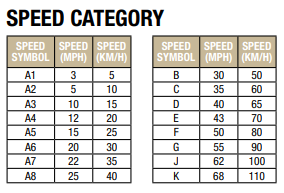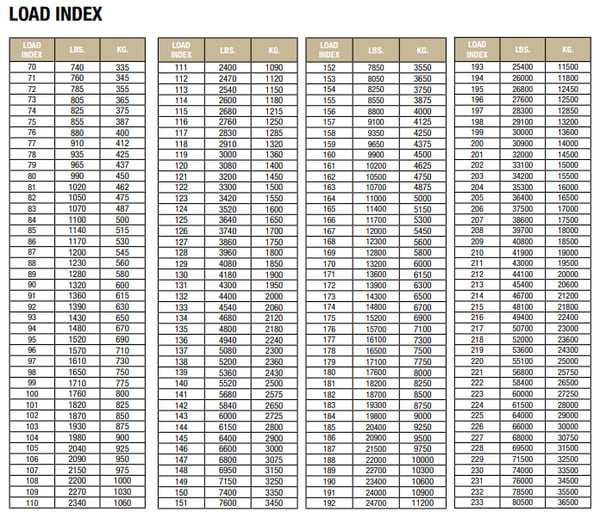A Farmer's Guide to Speed and Load Index
Shrinking profit margins and the need to feed a growing population are just a couple of reasons why farm equipment continues to get larger and more powerful. Coinciding with the growing size and power of farm machines is an increase in the speed at which they travel. As tractors evolve to meet the demands of today’s farmers, so must the tires those machines ride on. One such adaptation in response to farmers’ need for speed is the production of more ag tires with high-speed ratings.
High-Speed History
In the U.S., the sight of high-speed farm equipment is becoming more prevalent as the acreage of today’s farms grows, fields get more scattered, roading becomes more commonplace, and technology improves. In fact, feeling that equipment can’t get any larger due to restrictions and regulations on rural roads and managing soil compaction, some equipment manufacturers speculate that the trend of bigger farm machinery will give way to faster ag equipment. Some even speculate the trend will turn to smarter, faster, smaller equipment using multiple machines rather than one large piece of equipment.
History is a good indicator of the growth of high-speed equipment. The speed of tractors has almost doubled over the past four decades. At the beginning of the 1980s, tractors generally reached top speeds of 20 mph; but by the mid-1980s, machines with swapped gearing and upgraded brakes were cruising at speeds up to 25 mph. In the mid-1990s, higher gear ratios and front axle suspension saw tractors traveling at speeds up to 32 mph. Today’s high-tech tractors are routinely capable of traveling at speeds near 40 mph.
The challenge is that tires are engineered and manufactured for very specific loads and speeds. Overloading a tire can lead to overheating and tire failure. Overinflating it can interfere with the shape of its footprint and the flexibility of its sidewalls. It's vital therefore to choose a tire that can handle the job, and manage it properly so that it can function as designed.
Speed Rating
With the speed of farm equipment on the rise, safety concerns mandate that its tires are capable of traveling at those speeds. The best place to find this information is a tire’s load speed index, which indicates the speed a tire can travel when carrying a particular load.
Speed Symbol: The speed rating of an ag tire is represented by a speed symbol and correlates to the maximum speed a tire is designed to run. The common designations for farm tires are A8: 25 mph, B: 30 mph, and D: 40 mph.

Load Index: Normally a three-digit number precedes the speed rating of a tire; that number is the load index, or more simply the tire’s carrying capacity. Tire load ratings are standardized by the Tire and Rim Association (TRA), and the higher the number the more weight a tire can carry. Both a tire’s speed and load index are found on manufacturers’ websites and in their catalogs.
Here is a comprehensive list of load indexes, speed symbols, and other relevant tire reference tables.

Matching a Tire’s Load and Speed to Your Needs
Failing to have a tire capable of meeting the needs of your machine can have consequences ranging from frustrating (such as premature tire wear) to devastating (like injury or death) and everything in between. Because of this, you must know the weight your machine will bear—including fuel and the material it is designed to carry, whether it's spray, seed, grain, or something else—and the speed it will travel.
AgriFlex Advantage
A farmer’s need for faster equipment speeds is one of the reasons for the rapid adoption of IF/VF tires. IF tires can carry 20% more weight than a standard radial tire at the same inflation pressure and VF tires increase that advantage to 40%. That means IF/VF tires allow you to carry heavier loads without sacrificing the speed at which your tires can travel. For example, look at the speed and load capabilities of our Alliance 372 AgriFlex+ VF tire, a premium radial tire, and standard radial tire.
| Tire | Size | Load Index & Speed Symbol | Inflation | Speed/Load | Load/Load | |
| Alliance 372 AgriFlex+ VF | VF 710/70R42 | 185D | 23 psi | 12 mph/17,150 lbs | 40 mph/17,150 psi | |
| Premium Radial | 710/70R42 | 173D | 23 psi | 16 mph/14,640 lbs | 40 mph/12,350 lbs | |
| Standard Radial | 710/70R42 | 173AB/B | 26 psi | 16 mph/14,150 lbs |
|
The difference between the Alliance 372 AgriFlex+ VF tires and a conventional, premium radial tire is considerable—the AgriFlex+ VF construction can handle almost 5,000 lbs. more. As for the standard radial, it’s not rated for speeds of 40 mph.
Sometimes you don't need extra load or extra speed. Sometimes you do. Different operations and machines have different needs, and we have a tire for all of them.
If you need assistance finding the right tire to handle the needs of your fast-moving farm or simply want to learn more about our high-speed tire offerings, contact your local dealer or reach out to your rep today!

-1.jpg?width=800&name=Alliance_363_hagie_sprayer_2%20(26)-1.jpg)

